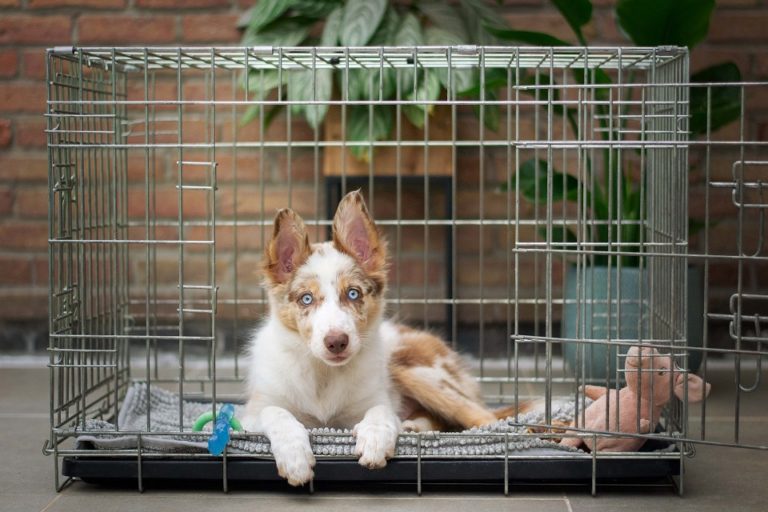Lilac French Bulldog Care and Breed Information: Lifespan & Size

This Lilac French Bulldog Care article will provide comprehensive information on this bulldog breed from physical characteristics to housing and environment.
Our goal is to educate potential owners on what to expect when owning a Lilac French Bulldog. We discuss helpful tips and advice for ensuring the well-being and happiness of these beloved pets.
Overview of Lilac French Bulldog
The Lilac French Bulldog is a rare and highly sought-after variation of the French Bulldog breed. They are characterized by their unique coat color, which ranges from pale lilac or silver to a deep purple hue.
Like other French Bulldogs, they have a compact and muscular build, a wrinkled face, and large, upright ears. They are a friendly and playful breed, known for their affectionate and comical personalities.
The Lilac French Bulldog breed has seen a significant increase in popularity and demand in recent years. This is due in part to their unique and eye-catching coat color, as well as their friendly and playful personalities.
Lilac French Bulldogs are highly sought after by breeders and pet owners alike and can command a premium price due to their rarity.
However, it’s important to note that high demand can lead to unscrupulous breeders who prioritize profit over the health and well-being of the dogs.
It’s crucial for potential owners to thoroughly research and carefully select a reputable breeder to ensure that they are getting a healthy and well-cared-for pup.
Appearance and coat color
Lilac French Bulldogs have a compact and muscular build, with a wrinkled face and large, upright ears. Their coat is short and smooth and comes in a range of shades from pale lilac or silver to a deep purple hue.
The unique coat color is the result of a genetic mutation and is highly prized by breed enthusiasts. It’s important to note that proper care and grooming are necessary to maintain the appearance and health of the coat.
Lilac French Bulldog Size and Weight
Lilac French Bulldogs are a small to medium-sized breed. Typically a full-grown Lilac French Bulldog weighs between 22 to 28 pounds and stands 11 to 13 inches tall.
They have a compact and muscular build, with a stocky and solid appearance. Despite their small size, they are a sturdy and well-proportioned breed, with a strong and athletic build.
Their weight can vary depending on factors such as age, diet, and exercise level, so it’s important for owners to monitor their weight and ensure that they are at a healthy and appropriate size.
Other Unique Features
Lilac French Bulldogs are characterized by several unique features, including:
- Coat color: Lilac French Bulldogs are prized for their rare and distinctive coat color, which ranges from pale lilac or silver to a deep purple hue. This unique coloration sets them apart from other French Bulldog breeds.
- Wrinkled face: French Bulldogs are known for their wrinkled faces, which add to their distinctive appearance.
- Large, upright ears: French Bulldogs have large, erect ears that are a prominent feature of the breed.
- Compact and muscular build: Despite their small size, Lilac French Bulldogs have a muscular and well-proportioned build, with a stocky and solid appearance.
- Playful and affectionate personalities: French Bulldogs are known for their friendly and playful personalities, and are often described as being affectionate and comical.
These unique features, combined with their small size and low exercise requirements, make Lilac French Bulldogs a popular choice for city living and apartment life.
Temperament and Personality
Exploring their temperament and personality can provide valuable insights into their behavior and tendencies.
🐶 Characteristics of Lilac French Bulldogs:
Lilac French Bulldogs are known for their friendly and playful personalities. They are affectionate and comical, and often bond closely with their owners. Some common characteristics of Lilac French Bulldogs include:
- Playful: Frenchies are known for their energetic and playful nature, and are often eager to play and engage with their owners and other pets.
- Affectionate: Frenchies are known for their affectionate and loving personalities, and are often described as being “lap dogs.” They enjoy being close to their owners and often crave attention and affection.
- Comical: Frenchies have a humorous and playful personalities, and often have a silly and lighthearted demeanor.
- Adaptable: Frenchies are a relatively adaptable breed, and can do well in a variety of living situations, including city living, apartment life, and suburban environments.
- Low exercise requirements: Frenchies are a low-energy breed and do not require a lot of exercises to maintain their health and well-being.
- Good with children: Frenchies are often good with children and make great family pets, although it’s important to supervise any interactions between dogs and young children to ensure their safety.
These characteristics, along with their distinctive appearance, make Lilac French Bulldogs a popular and beloved breed.
However, potential owners need to keep in mind that every dog is unique and may have different personality traits and behaviors.
🐶 Suitability As a Pet:
Lilac French Bulldogs can make excellent pets for the right person or family. They are a friendly and affectionate breed, known for their playful and comical personalities. Some factors that make Frenchies well-suited as pets include:
- Low exercise requirements: Frenchies are a low-energy breed and do not require a lot of exercises to maintain their health and well-being.
- Adaptability: Frenchies are a relatively adaptable breed, and can do well in a variety of living situations, including city living, apartment life, and suburban environments.
- Good with children: Frenchies are often good with children and make great family pets, although it’s important to supervise any interactions between dogs and young children to ensure their safety.
- Affectionate: Frenchies are known for their affectionate and loving personalities, and are often described as being “lap dogs.” They enjoy being close to their owners and often crave attention and affection.
However, potential owners should also keep in mind that Frenchies can have some health issues, and can be prone to certain genetic disorders. They also tend to snore and drool and may have flatulence.
It’s important to thoroughly research the breed and speak with a veterinarian before adopting a Lilac French Bulldog to ensure that they are the right pet for your lifestyle and needs.
🐶 Socialization and Training Needs:
Lilac French bulldogs, like all dogs, require socialization and training to become well-behaved and confident pets.
Socialization involves exposing them to a variety of people, places, and experiences so they can learn to feel comfortable and safe in different environments.
Training involves teaching basic obedience commands, such as “sit,” “stay,” and “come,” as well as house training and proper leash walking. Consistent and positive reinforcement is key in both socialization and training.
It’s important to start early and continue throughout the dog’s life to ensure they develop good behavior and a strong bond with its owner.
Health Considerations
🐶 Common Health Issues:
Lilac French bulldogs, like all purebred dogs, have a higher risk of certain health issues due to their limited gene pool. Some of the common health issues to keep in mind include:
- Brachycephalic airway syndrome: Lilac French bulldogs have a short snout, which can lead to breathing difficulties and heat intolerance.
- Skin allergies: French bulldogs are prone to skin allergies, which can cause itching, redness, and hair loss.
- Hip dysplasia: Hip dysplasia is a hereditary condition that affects the joint and can lead to arthritis and lameness.
- Intervertebral disc disease: French bulldogs are prone to intervertebral disc disease, which can cause pain and mobility issues.
- Cherry eye: Cherry eye is a common eye condition in French bulldogs, where the tear gland prolapses and becomes visible.
- Deafness: French bulldogs have a higher risk of congenital deafness, which can be bilateral (affecting both ears) or unilateral (affecting one ear).
It’s important to have regular veterinary check-ups and to monitor your dog’s health regularly to detect and treat any potential health issues early.
🐶 Life Expectancy:
The average life expectancy of a Lilac French bulldog is about 10 to 12 years. However, this can vary depending on factors such as diet, exercise, genetics, and overall health.
Keeping them happy can help extend a Lilac French bulldog’s lifespan and ensure they live a happy and healthy life.
🐶 Importance of Regular Vet Check-ups:
Regular veterinary check-ups are important for the overall health and well-being of your Lilac French bulldog. They can help detect and prevent potential health problems early on when they are easier to treat.
During a veterinary check-up, the vet will examine your dog and perform any necessary tests to assess their health. They may also give vaccinations, provide preventive care advice, and update any necessary medical records.
Regular check-ups can also help establish a relationship between you and your vet, making it easier to ask questions and address any concerns about your dog’s health.
It’s also an opportunity for you to discuss your dog’s diet, exercise, and behavior and to receive advice on how to best support their overall health and well-being.
In short, regular veterinary check-ups are an important part of responsible pet ownership and can help ensure that your Lilac French bulldog lives a long, healthy, and happy life.

Feeding and Nutrition
Feeding and nutrition are very important to a dog’s overall health and well-being. A balanced diet can help maintain their physical and mental health, as well as prevent a variety of health problems.
🐶 Dietary Requirements:
Lilac French bulldogs have specific dietary requirements to meet their nutritional needs and support their overall health. Some general guidelines for feeding a Lilac French bulldog include:
- Quality food: Feed your dog a high-quality, well-balanced diet that meets their specific nutritional needs. You can choose between commercial dog food or a home-cooked diet, but make sure it meets AAFCO (Association of American Feed Control Officials) standards for a complete and balanced diet.
- Portion control: Overfeeding can lead to obesity, which can put a strain on their joints and other health issues. Feed your dog the recommended portion size based on their weight, age, and activity level.
- Regular meals: Feed your dog two or three small meals a day, instead of one large meal, to help prevent bloat and other digestive issues.
- Avoid table scraps: Avoid feeding your dog table scraps, as this can upset their digestive system and lead to weight gain.
- Hydration: Make sure your dog has access to fresh water at all times and encourage them to drink regularly to prevent dehydration.
It’s important to consult with your veterinarian to determine the specific dietary requirements for your Lilac French bulldog. Because they may have unique needs based on their age, size, and health status.
🐶 Recommended Food Types and Brands:
For a healthy diet, it’s recommended to feed a Lilac French Bulldog high-quality dog food that is specifically formulated for its breed and size. Some of the best dog food brands for Lilac French Bulldogs are:
- Royal Canin French Bulldog Adult dry dog food
- Wellness Complete Health Natural Dry Small Breed Dog Food
- Orijen Six Fish Grain-Free Dry Dog Food
- Hill’s Science Diet Small Paws for Small Breeds Adult Dry Dog Food
- Blue Buffalo Life Protection Dry Dog Food
It’s important to choose a brand that uses high-quality proteins, such as chicken, fish, or lamb, and to avoid fillers like corn, wheat, and soy.
It’s also recommended to feed your dog a balanced diet of both dry and wet food to ensure they are getting all the nutrients they need. Consult with your veterinarian to determine the best diet for your dog.
🐶 Portion Sizes and Feeding Frequency:
The portion size and frequency of feeding for a Lilac French Bulldog depend on several factors such as age, weight, activity level, and overall health.
As a general guideline, it’s recommended to feed adult French Bulldogs 2 to 3 small meals a day, each consisting of about 1/2 to 1 cup of high-quality dry dog food.
Puppies may need to be fed more frequently, up to 4 times a day, in smaller portions.
It’s important to not overfeed your dog, as French Bulldogs are prone to obesity, which can lead to health issues such as joint problems and respiratory difficulties.
It’s always best to consult with your veterinarian to determine the appropriate portion size and frequency of feeding for your dog based on their unique needs and circumstances.
Exercise and Activity
Regular exercise and physical activities are essential for a dog’s physical and mental health. Also can help maintain a healthy weight, strengthen muscles, and improve cardiovascular health while reducing the risk of certain health problems.
🐶 Physical Activity Needs:
Lilac French Bulldogs are a small breed with a moderate energy level, and they typically enjoy a moderate amount of physical activity each day.
They are well-suited to apartment living, but they still need daily exercise to stay healthy and happy. Some recommended physical activities for Lilac French Bulldogs include:
- Short walks: Two to three 20-minute walks a day are enough to meet their daily exercise needs.
- Playtime: Interactive toys and games such as fetch, tug-of-war, or hide-and-seek can provide mental and physical stimulation.
- Training: Basic obedience training and puzzle toys can provide mental stimulation and improve obedience.
- Swimming: Frenchies are prone to heat stroke, so swimming can be a great way for them to exercise without getting overheated.
It’s important to note that Frenchies can easily become overweight, so it’s important to monitor their food intake and provide appropriate physical activity to maintain a healthy weight.
Consult with your veterinarian for a personalized exercise plan for your Lilac French Bulldog.
🐶 Indoor and Outdoor Playtime:
Lilac French Bulldogs are a small breed well-suited to apartment living and can get enough exercise indoors. However, they still benefit from outdoor playtime, as long as it’s in a safe, secure environment.
For indoor playtime, some recommended activities include:
- Interactive toys: such as puzzle toys chew toys or treat-dispensing toys
- Playtime with family: playing fetch, tug-of-war, or hide-and-seek can provide both physical and mental stimulation
For outdoor playtime, some recommended activities include:
- Walks: Two to three 20-minute walks a day can provide sufficient exercise
- Playtime in the yard: games of fetch or tug-of-war can be great outdoor activities
- Swimming: Frenchies are prone to heat stroke, so swimming can be a great way for them to exercise without getting overheated
It’s important to always supervise your Lilac French Bulldog when they are outside, as they are a brachycephalic breed and can be prone to overheating, especially in hot weather.
Additionally, make sure the outdoor area is secure and free of potential hazards, such as poisonous plants or dangerous objects.
🐶 Importance of Exercise for Health and Well-being:
Exercise is important for the health and well-being of Lilac French Bulldogs and all dogs. Regular physical activity provides numerous benefits, including:
- Maintains a healthy weight: Regular exercise helps to prevent obesity, which can lead to serious health problems such as joint problems, respiratory difficulties, and heart disease.
- Improves heart health: Exercise increases blood flow, strengthens the heart, and helps to prevent heart disease.
- Enhances mental well-being: Exercise provides mental stimulation, helps to reduce anxiety and stress, and can improve mood.
- Improves joint health: Regular exercise can improve joint flexibility and mobility, helping to prevent arthritis and other joint problems.
- Supports digestive health: Exercise can help to improve digestive health by promoting regular bowel movements and reducing the risk of constipation.
- Strengthens the immune system: Regular exercise can help to boost the immune system, making the dog less susceptible to illness and infection.
It’s important to note that Lilac French Bulldogs are prone to heat stroke, so it’s important to monitor their activity and ensure they have access to plenty of water during exercise.
Consult with your veterinarian to determine the appropriate amount of exercise for your dog based on its unique needs and circumstances.
Grooming and Hygiene
Lilac French Bulldogs have a short, smooth coat that requires minimal grooming. However, keeping their coat clean and free of tangles and mats is important to maintain their appearance and overall skin health.
Here are some tips for coat care and brushing:
- Brush regularly: Regular brushing helps to remove loose hair and prevent tangles and mats. A slicker brush or rubber brush can be used for this.
- Bathe as needed: Frenchies do not need to be bathed frequently, but if they get dirty, a bath can help to keep their coat clean and free of dirt and debris. Use a gentle dog shampoo to avoid skin irritation.
- Trim nails: Regularly trim your Lilac French Bulldog’s nails to prevent cracking and splitting, which can be painful.
- Clean ears: Frenchies are prone to ear infections, so it’s important to keep their ears clean and dry. Use a cotton ball and a gentle cleaner recommended by your vet to clean the inside of their ears.
- Brush their teeth: Regular brushing can help to prevent plaque and tartar build-up, keeping their teeth and gums healthy.
It’s important to note that some Frenchies are prone to skin allergies, so it’s important to monitor their skin and consult with your veterinarian if you notice any signs of irritation or infection.
Housing and Environment
Lilac French Bulldogs are a small breed that is well-suited to apartment living, but they also do well in homes with small yards. They are a low-energy breed that does not require a lot of space to be happy and healthy.
Here are some factors to consider when choosing suitable living arrangements for your Lilac French Bulldog:
- Space: Frenchies do not need a lot of space, but they do need enough room to move around comfortably and play. A small apartment or house with a small yard is ideal.
- Climate: Frenchies are prone to overheating, so it’s important to consider the climate when choosing a living arrangement. A home with air conditioning is ideal in hot climates, and a warm, well-insulated home is important in cold climates.
- Safety: Frenchies should always be kept in a safe, secure environment to prevent them from running away or getting lost. A secure yard or a leash when outside is important.
- Access to outdoors: Frenchies need daily exercise, so access to a yard or nearby park is important.
- Socialization: Frenchies are social dogs and do best when they have plenty of interaction with their human family and other dogs. They are well-suited to apartment living as long as they receive plenty of socialization and exercise.
It’s important to consider your lifestyle and the needs of your Lilac French Bulldog when choosing a living arrangement. Consult with your veterinarian for guidance and recommendations based on your circumstances.
Conclusion
In conclusion, Lilac French Bulldogs are a small, affectionate breed that is well-suited to apartment living or homes with a small yard. They have moderate exercise needs and a short, smooth coat that requires minimal grooming.
They are prone to heat stroke, so it’s important to monitor their activity and ensure they have access to plenty of water during exercise. Frenchies are also prone to ear infections, so it’s important to keep their ears clean and dry.
Regular brushing and bathing, as well as trimming their nails and brushing their teeth, are important for maintaining their overall health and appearance.
To ensure a happy and healthy life for your Lilac French Bulldog, it’s important to choose a living arrangement that is safe, and secure, and provides access to plenty of exercise and socialization.
Consult with your veterinarian for personalized advice and recommendations based on your circumstances.
Frequently Asked Questions
Here, you’ll find answers to some of the most common questions about Lilac French Bulldogs. We’ve gathered information from experts and reliable sources to provide you with accurate and helpful answers.
If you can’t find the information you’re looking for, don’t hesitate to reach out to us for further assistance. We’re here to help!
What is Lilac French Bulldog Price?
The price of a Lilac French Bulldog can vary greatly depending on several factors, including the breeder, location, and bloodline of the dog. On average, a Lilac French Bulldog price can cost anywhere from $5,000 to $20,000 or more.
It’s important to keep in mind that buying a dog from a reputable breeder is always better than buying from a pet store or a backyard breeder. A reputable breed typically offers health guarantees and raises the dogs in good condition.
If you do online research you can find a good dog breeder who offers Lilac French Bulldog for sale at a reasonable price.
Is Lilac a Rare Color for French Bulldogs?
Yes, Lilac is considered a rare and unique color for French Bulldogs. This color is achieved through selective breeding and is highly sought after by French Bulldog enthusiasts.
Due to the high demand and limited availability, Lilac French Bulldogs are often more expensive than other colored Frenchies.
It’s important to note that the price should not be the only factor when considering the purchase of a dog and one should prioritize the health and well-being of the animal.
How do I know if my puppy is blue or lilac?
The color of a French Bulldog puppy can be difficult to determine at first, as the color may change as the dog grows.
To determine if your puppy is blue or lilac, you should look at the color of its nose leather and eye rims, as these are typically the first areas to show the true color of the dog.
Lilac Frenchies have a light, pale grayish-lavender color on their nose leather and eye rims. Blue Frenchies, on the other hand, have a blue-gray color on their nose leather and eye rims.
It’s also important to note that there are variations in the intensity of these colors, and some dogs may be lighter or darker than others.
It’s best to consult with a veterinarian or a reputable breeder to get a more accurate assessment of your puppy’s color.
How do you know if your dog is lilac?
To determine if your French Bulldog is a lilac, you should look at the color of its coat, which should be a light, pale grayish-lavender shade.
This color is a result of a genetic mutation and is achieved through selective breeding. Some dogs may have lighter or darker lilac coats, but the overall shade should be consistent.
It’s important to note that the color of a French Bulldog’s coat can change as the dog grows, so it may be necessary to have an expert, such as a veterinarian or a reputable breeder, assess the dog to determine its true color.
It’s also important to consider that there are other colors of French Bulldogs, such as fawn, brindle, and cream, and it’s possible for a dog to have a coat that appears to be lilac, but it could change to a different color with time.
A reputable breeder or expert can help you accurately determine the color of your French Bulldog.
Is Lilac French Bulldog aggressive?
The temperament of a Lilac French Bulldog, like any other dog, depends on several factors, including genetics, socialization, and training.
French Bulldogs, in general, are known for being friendly, affectionate, and playful. They are typically good with children and other animals and are not typically aggressive.
That being said, no breed is complete without the possibility of aggressive behavior, and it’s important to remember that all dogs, regardless of breed.
Every dog breed has the potential to exhibit aggressive behavior if they are not properly socialized and trained.
It’s important to provide your dog with proper socialization and training from a young age and to continue this training throughout their life to ensure that they are well-behaved and friendly.
If you have concerns about your dog’s behavior, it’s always best to consult with a professional dog trainer or behaviorist.






